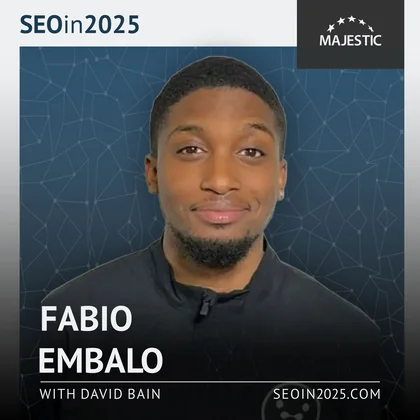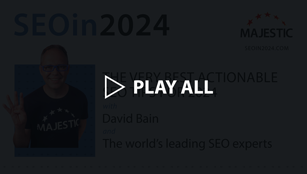-
Site Explorer
- Majestic
- Summary
- Ref Domains
- Backlinks
 New
New Lost
Lost- Context
- Anchor Text
- Pages
- Topics
- Link Graph
- Related Sites
- Advanced Tools
- Author ExplorerBeta
- Summary
- Similar Profiles
- Profile Backlinks
- Attributions
- Compare
-
Link Tools
- My Majestic
- Recent Activity
- Reports
- Campaigns
- Verified Domains
- OpenApps
- API Keys
- Keywords
- Keyword Generator
- Keyword Checker
- Search Explorer
- Link Tools
- Bulk Backlinks
- Neighbourhood Checker
- Submit URLs
- Experimental
- Index Merger
- Link Profile Fight
- Mutual Links
- Solo Links
- PDF Report
- Typo Domain
- Free SEO Tools
- Support
Emphasise user experience and leverage AI to synergise your content and branding
Fabio Embalo
While Fabio Embaló from Viaduct Generation is also all about the user experience, he encourages you to make use of AI-driven tools in the process.

Emphasise user experience and leverage AI to synergise your content and branding
Fabio says: “In 2025, we all need to adjust our SEO strategies and carry on prioritising user experience.
However, we should start leveraging AI-driven content and branding synergy to ensure that there’s a specific emphasis on mobile-first indexing as search engines will evolve to deeply understand user intent and content relevance.”
How do you use AI and machine learning to analyse search trends?
“With the massive eruption of ChatGPT from OpenAI, the opportunity has shifted. At the start, everyone was scratching their heads over the possibility of losing their jobs and there was a lot of scaremongering. Now it’s established, and it’s here to stay and evolve.
For content creation, you can use AI-driven tools, like ChatGPT or Jasper, to generate topic ideas and refine content for better relevance to search trends. This will save time and ensure your content stays aligned with current user intent.
With AI being here to stay, clients’ priorities have shifted a little bit. Their timelines are more rigid, and people are expecting results and ROI a lot sooner than before. As SEOs, we need to find a way to save time on laborious tasks. Things like AI and machine learning can help you get rid of those tasks so that you can focus on implementing and creating strategies.
It allows you to be more creative with your time, rather than doing things that we now have the tools to take off your schedule.”
How do you ensure that the content that AI produces matches the user intent that you are targeting?
“First and foremost, you need to ensure that you understand the target audiences that your clients have in mind. The best way to use AI, in general, is by feeding it as much information as you possibly can.
If you feed the AI information and you’re very structured with the prompts that you give it, you will get the right results. As long as you know the target audience, and you’re able to explain that to a tool like ChatGPT, then the results will show you whether the robot understands what you want.
You need to understand the user intent yourself first. Don’t just jump on AI and expect it to produce a piece of content without understanding your own user journey. Build the user journey, apply typical types of content to it, explain that to an AI, and explain the intent behind it.
I tend to leverage it as much as I possibly can on the laborious tasks that it can handle. For every single one of my clients, I’ve created a tone-of-voice sheet and, within that, I have a specific paragraph that talks about their targets, their competitors, and the products or services that they offer. I also include different blog examples that I’ve created, different descriptions, or product category pages.
The more information you give it, the better. If I just go onto ChatGPT right now and type in, ‘best ways to answer questions for SEOin2025’, the answers will be too broad. However, if I input information about SEOin2025, David Bain, Majestic, some of the points that I want to discuss, who I am as a person, and what I normally discuss, it will understand all of that context. The output it provides will be very different from what I would have received if I hadn’t fed it all of that information.”
How do you select the optimum tool for the job?
“Trial and error will always be a thing. In our agency, we still do A/B tests for different pages, the content that we create, the specific places to put the CTAs, etc. We trial different things to see what works best for our target audience.
With AI tools, it is the same. Jasper, for example, is very good at ideation. If I feed Jasper the keywords I’m aiming to optimize for and create a strategy with, the topics it comes up with are interesting enough that it gives me a good foundation to expand on with my creative ideas. ChatGPT feels a bit too basic if you don’t feed it the right information.
Speaking to a lot of my developer friends (and even when I’m doing a bit of coding myself), ChatGPT doesn’t read lines of code as well as you would expect it to – yet. It’s only a matter of time, and it depends on how much information you feed it.
Trial it, and use the plugins that ChatGPT now has to enhance it. Try to see which one works best for whatever tasks you are aiming to achieve.
I have some plugins running in the background most of the time. I use them to help me come up with different ideas for LinkedIn posts every month, for example. You want to ensure that the content is appropriate for the medium that it’s being published on, and you can use plugins to make sure that the language is right.
When I was learning a bit of JavaScript, I used a plugin called Code Tutor within ChatGPT, which is actually very good. It’s almost like you have an AI tutor that helps you understand code a little bit better. There are loads of them, and they are categorised now. They have some for writing, some for productivity, some for research, and others for programming.
A lot of these plugins enhance the experience that ChatGPT offers. At the very start, it was like a search bar where you typed in whatever query you wanted and then it would give you a result. With the plugins, it’s like a DLC for a video game. It enhances the experience of the bot.”
How has search been changing regarding visual and voice searches, and how is that impacting SEO?
“I was recently talking with one of my friends who is also an SEO, and we were talking about how it feels like voice search has disappeared a bit. About 5 years ago, it was the hottest topic, which happens every time there’s a new toy for SEOs. People were talking about the death of SEO just because of voice search.
I do optimize for voice searches, and a lot of my clients benefit from it. I implement structured data and long tail keyword phrases that align with natural speech patterns, because that will help the content show up in voice search results. The same thing is true with visual search.
A more common issue that I see with a lot of the clients is that, even today, the majority of websites that come our way are still not optimizing their images properly or understanding how to have a strategy behind that.
Ensure that your images are of high quality, use descriptive file names, and have relevant alt texts. Another thing that a lot of people seem to overlook is implementing image search schema markup. You want to have both structured data for voice search and schema markup for your images.”
Is the primary reason why you’re optimizing your images to be found in Google image search?
“No. At brightonSEO not too long ago, I talked about how I believe that optimizing your images should be for accessibility reasons. You and I can easily go onto a website right now, navigate it, and understand exactly what images we’re looking at. However, if you are someone with visual impairments and you’re using a screen reader, that screen reader might not be able to explain the image to you.
In my opinion, the top priority for image optimization should always be accessibility, to ensure that your website is welcoming and easy to access for everyone – no matter what walk of life they are from. However, it certainly does help for search engines as well.”
Where does branding fit into the modern world of AI-enhanced SEO?
“There’s an agency called Rise and, for a couple of years, they’ve been screaming at the top of their lungs about the merge that’s happening between SEO and branding. At the end of the day, everything has changed. With things like the TikToks of the world, Google is clearly panicking about the lack of engagement that Gen Z and Gen Alpha have with Google as a search engine. Instead, they mainly use TikTok for all their searches.
Brands have also started paying a lot more attention to how they come across on platforms like TikTok and Instagram. Creating the buzz on your socials, through the use of your brand, will create a halo effect with your SEO. It has a direct impact on SEO in terms of things like growth in direct traffic and branded search terms, and on enhancing the user experience with things like dwell time, lower exit rates from the site, etc.
When it comes to brand and SEO, you want to look at the bigger picture rather than ignoring everything else. You need to keep branding and all the other marketing departments as part of your SEO strategy to ensure that the brand is being enhanced through your efforts.”
If an SEO is struggling for time, what should they stop doing right now so they can spend more time doing what you suggest in 2025?
“If you’re struggling for time, cut down on the manual tasks that automation can handle – like basic reporting or routine technical audits. Tools will continue to get better and better at handling repetitive tasks, which allows you to focus more on strategy and creativity, and the overall user experience.
Going forward in 2025, it’s all about staying ahead by focusing on content that speaks directly to your audience’s needs. You need to understand intent better than ever and leverage AI to help with things like content optimization.
Prioritise refining the user journey and measuring what really matters, like conversions and engagement, rather than vanity metrics. Let the automation handle the groundwork so you can focus on strategy and growth.”
Fabio Embaló is CEO at Viaduct Generation, and you can find him over at ViaductGen.com.
Also with Fabio Embalo
Choose Your Own Learning Style
 Video
Video
If you like to get up-close with your favourite SEO experts, these one-to-one interviews might just be for you.
Watch all of our episodes, FREE, on our dedicated SEO in 2025 playlist.
 Podcast
Podcast
Maybe you are more of a listener than a watcher, or prefer to learn while you commute.
SEO in 2025 is available now via all the usual podcast platforms
Don't miss out
Opt-in to receive email updates.
It's the fastest way to find out more about SEO in 2025.
Could we improve this page for you? Please tell us





